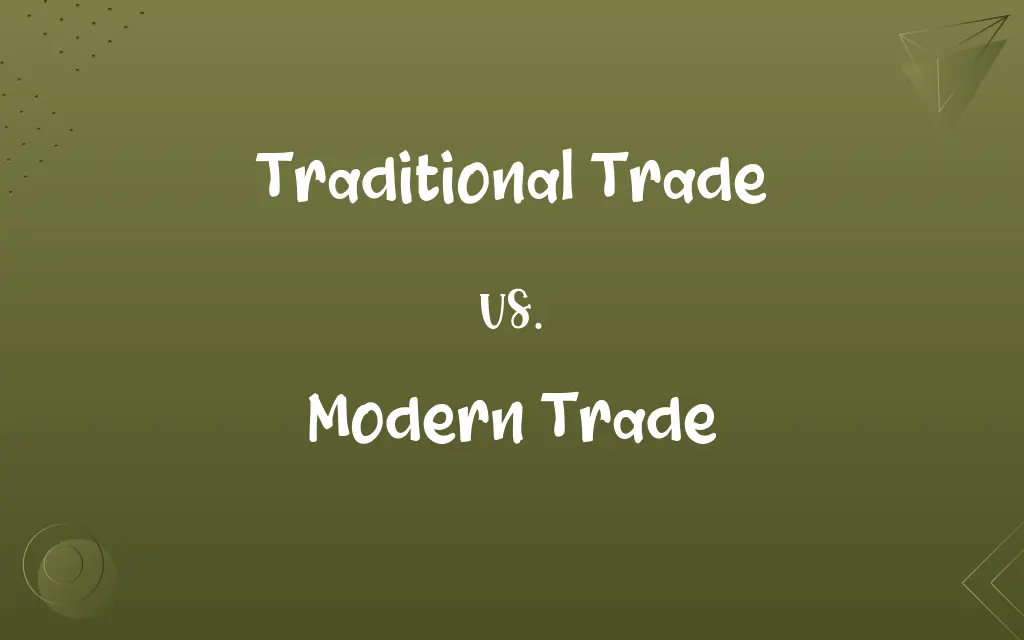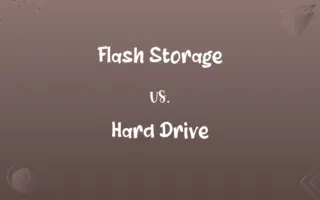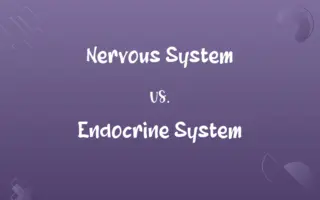Traditional Trade vs. Modern Trade: Know the Difference

By Shumaila Saeed || Updated on December 25, 2023
Traditional trade involves local, small-scale, often personalized commerce; modern trade is characterized by large-scale, technology-driven, and impersonal retail environments.

Key Differences
Traditional trade typically refers to small-scale, local business operations, often family-owned and operated, emphasizing personal customer relationships and service. Modern trade, in contrast, involves larger retail formats like supermarkets and chain stores, leveraging technology and scale for efficiency and a wide product range.
Shumaila Saeed
Nov 13, 2023
In traditional trade, the focus is on direct sales, often in open markets or small shops, with limited product variety but strong community integration. Modern trade employs extensive distribution networks, centralized purchasing, and often includes online platforms, offering a vast array of products to a broader market.
Shumaila Saeed
Nov 13, 2023
Traditional trade usually relies on manual processes for inventory, sales, and customer service, leading to a more personalized but less efficient system. Modern trade, however, utilizes advanced technologies such as electronic data interchange, automated inventory management, and digital marketing, enhancing efficiency and reach.
Shumaila Saeed
Nov 13, 2023
Payment methods in traditional trade are often cash-based and might include bartering in some cultures. Modern trade predominantly uses electronic payment systems, credit/debit cards, and digital wallets, facilitating faster and more secure transactions.
Shumaila Saeed
Nov 13, 2023
Lastly, traditional trade is often characterized by its sustainability in using local resources and low carbon footprint, while modern trade, with its global supply chains and reliance on mass production, has a more significant environmental impact but offers cost and time efficiency.
Shumaila Saeed
Nov 13, 2023
ADVERTISEMENT
Comparison Chart
Scale of Operation
Small-scale, often local
Large-scale, often multinational
Shumaila Saeed
Nov 13, 2023
Business Model
Family-owned, personalized service
Corporate chains, impersonal service
Shumaila Saeed
Nov 13, 2023
Technology Use
Limited, mostly manual processes
High-tech, including digital platforms
Shumaila Saeed
Nov 13, 2023
Product Variety
Limited variety, local products
Wide variety, including global brands
Shumaila Saeed
Nov 13, 2023
Distribution Network
Direct sales, local markets
Extensive networks, online and offline presence
Shumaila Saeed
Nov 13, 2023
ADVERTISEMENT
Customer Interaction
Personalized, community-oriented
Impersonal, efficiency-focused
Shumaila Saeed
Nov 13, 2023
ADVERTISEMENT
Traditional Trade and Modern Trade Definitions
Traditional Trade
Traditional trade often involves face-to-face interactions and cash-based transactions.
Buying fish from a local fisherman's stall is a traditional trade practice.
Shumaila Saeed
Nov 10, 2023
Modern Trade
This form of trade employs digital payment systems and automated inventory management.
Using a mobile app to pay at a chain coffee shop is part of modern trade.
Shumaila Saeed
Nov 10, 2023
Traditional Trade
Traditional trade encompasses local, often family-run businesses focusing on direct sales.
The corner grocery store, run by the same family for generations, is an example of traditional trade.
Shumaila Saeed
Nov 10, 2023
Modern Trade
Modern trade often involves multinational corporations and global supply chains.
Purchasing a smartphone that's been assembled across different countries is a result of modern trade.
Shumaila Saeed
Nov 10, 2023
Traditional Trade
Traditional trade is rooted in cultural practices and sustains local economies.
A family-owned bakery that uses century-old recipes is a classic case of traditional trade.
Shumaila Saeed
Nov 10, 2023
Modern Trade
Modern trade is characterized by impersonal service but efficient and standardized processes.
Self-checkout at a big-box store is a feature of modern trade.
Shumaila Saeed
Nov 10, 2023
Traditional Trade
It's a commerce system where personalized service and local community relationships are key.
A farmer selling produce at a local market is engaging in traditional trade.
Shumaila Saeed
Nov 10, 2023
Modern Trade
It features centralized purchasing, diverse product offerings, and often includes online sales platforms.
Buying groceries online from a retail giant exemplifies modern trade.
Shumaila Saeed
Nov 10, 2023
Traditional Trade
This form of trade is characterized by manual inventory and accounting systems.
A local artisan keeping track of sales in a ledger is practicing traditional trade.
Shumaila Saeed
Nov 10, 2023
Modern Trade
Modern trade refers to large-scale retail operations using advanced technology and extensive distribution networks.
Shopping at a multinational supermarket chain is an instance of modern trade.
Shumaila Saeed
Nov 10, 2023
Repeatedly Asked Queries
How does customer service differ in traditional trade?
It's more personalized and community-oriented.
Shumaila Saeed
Nov 13, 2023
What is the environmental impact of modern trade?
It tends to be higher due to global supply chains and mass production.
Shumaila Saeed
Nov 13, 2023
Are bartering and cash transactions part of traditional trade?
Yes, these are common in traditional trade settings.
Shumaila Saeed
Nov 13, 2023
How does traditional trade benefit communities?
It fosters local economies and sustains cultural practices.
Shumaila Saeed
Nov 13, 2023
What payment methods are typical in modern trade?
Digital payments and credit/debit cards are common.
Shumaila Saeed
Nov 13, 2023
How do inventory management systems differ?
Traditional trade uses manual systems, while modern trade employs automated systems.
Shumaila Saeed
Nov 13, 2023
What technology is used in traditional trade?
It mostly involves manual processes and minimal technological integration.
Shumaila Saeed
Nov 13, 2023
What is modern trade?
Large-scale retail, often multinational, with advanced technological integration.
Shumaila Saeed
Nov 13, 2023
How does modern trade affect product variety?
It offers a wider range of products, including global brands.
Shumaila Saeed
Nov 13, 2023
What defines traditional trade?
It's characterized by small-scale, local, often family-run business models.
Shumaila Saeed
Nov 13, 2023
Can modern trade practices be integrated into traditional trade?
Yes, especially in areas like payment methods and marketing.
Shumaila Saeed
Nov 13, 2023
How does technology impact modern trade?
It enhances efficiency, reach, and customer experience.
Shumaila Saeed
Nov 13, 2023
What role does community play in traditional trade?
It's central, with strong relationships and direct customer interactions.
Shumaila Saeed
Nov 13, 2023
What challenges do traditional trades face in the modern economy?
Competition with large retailers and adapting to new consumer preferences are major challenges.
Shumaila Saeed
Nov 13, 2023
How does modern trade affect consumer choices?
It expands choices but can also lead to standardized products.
Shumaila Saeed
Nov 13, 2023
Is online shopping a part of modern trade?
Yes, it's a key component of modern trade's reach and convenience.
Shumaila Saeed
Nov 13, 2023
Can traditional trade utilize online platforms?
Increasingly, traditional businesses are also adopting online sales methods.
Shumaila Saeed
Nov 13, 2023
Can traditional trade compete with modern trade?
It can, especially in offering personalized services and unique products.
Shumaila Saeed
Nov 13, 2023
Are traditional trade practices environmentally sustainable?
Generally, yes, due to their local nature and lower carbon footprint.
Shumaila Saeed
Nov 13, 2023
How do traditional and modern trade differ in scale?
Traditional trade is small-scale, while modern trade operates on a much larger scale.
Shumaila Saeed
Nov 13, 2023
Share this page
Link for your blog / website
HTML
Link to share via messenger
About Author
Written by
Shumaila SaeedShumaila Saeed, an expert content creator with 6 years of experience, specializes in distilling complex topics into easily digestible comparisons, shining a light on the nuances that both inform and educate readers with clarity and accuracy.









































































